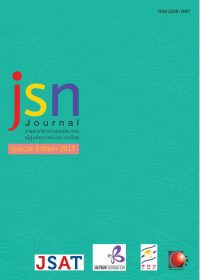Culture Industry and the Diversity of Kawaii Culture: Characters: Hello Kitty and Kumamon
Main Article Content
Abstract
This paper provides information and fundamental knowledge of Kawaii (cute) culture, which is a part of the pop culture in Japan, which has a long historical background. The Kawaii culture has been transformed by the changes of society, time and people, which became the diversity of Kawaii. Thus there is still no reason apparent as to why the diversity of Kawaii had occurred in Japan. The objective of this study was to explore the causes of the diversity development in the Kawaii culture by examining academic documents and other materials, including comics, films and web-sites. In addition, the research mainly focused on the Kawaii culture from the 1960s to the present.
The study showed that the transformations of the Kawaii culture were led by the changes of Japanese society, industries, and governmental policies after World War II. The concept of Kawaii culture were transformed into products in various forms to respond to the consumers’ needs. Additionally, Kawaii culture was expanded to cultural products, by the Japanese government. It was linked to tourism which is related to the localism value, so Kawaii culture became the towns’ symbols. And after linking into the various assorted cultures, then came the diversity of Kawaii culture. Additionally, exportation of the Kawaii products to other countries, created the assimilation between Kawaii culture and foreign culture, which finally led to differentiation and diversity of Kawaii.
Article Details
ข้อความและข้อคิดเห็นต่างๆ ในบทความเป็นของผู้เขียนบทความนั้นๆ ไม่ใช่ความเห็นของกองบรรณาธิการหรือของวารสาร jsn Journal
References
กาญจนา แก้วเทพ. (2553). แนวพินิจใหม่ในสื่อสารศึกษา. กรุงเทพฯ: ภาพพิมพ์.
เกษม เพ็ญภินันท์. (2553, 4 มิถุนายน). รายงานสัมมนา: “อุตสาหกรรมวัฒนธรรม” สำรวจแนวคิดจนถึงนโยบาย แล้วไทยจะไปทางไหน. เข้าถึงได้จาก http://prachatai.com/journal/2010/08/30/855
จารุวรรณ เจตเกษกิจ. (2555). การใส่วัฒนธรรมเข้าไปในตัวสินค้า. อุตสาหกรรมสาร, 54(6), 18-19.
บารนี บุญทรง. (2544). บทบาทหน้าที่ของผู้หญิงทำงานในสังคมญี่ปุ่นตั้งแต่สงครามโลกครั้งที่สอง. วารสารศิลปศาสตร์, 4(2), 41-63.
วาสนา ปานนวม. (2555). การส่งเสริมการ์ตูนของญี่ปุ่น: เครื่องมือเพิ่ม Soft Power และผลประโยชน์ทางเศรษฐกิจ. วารสารญี่ปุ่นศึกษา, 29(1), 76-85.
เหมือนฝัน มานตรี. (2556). การเผยแพร่เพลงกระแสนิยมญี่ปุ่นภายใต้กระแสโลกาภิวัฒน์: กรณีศึกษาศิลปินวงเอเคบี 48. สารนิพนธ์ศิลปศาสตรมหาบัณฑิต, สาขาวิชาการสื่อสารและวัฒนธรรมญี่ปุ่น, คณะภาษาและการสื่อสาร, สถาบันบัณฑิตพัฒนบริหารศาสตร์.
อรรถ บุนนาค. (2551). Cool Japan พลังทางวัฒนธรรม. Japan Letter. ญี่ปุ่นสาร, (58), 8-10. เข้าถึงได้จาก http://www.jfbkk.or.th/images/publication/j_letter_58.pdf
อุบลรัตน์ ศิริยุวศักดิ์ (2554). อุตสาหกรรมวัฒนธรรมและ “เอเซียภิวัฒน์” : เศรษฐกิจระหว่างประเทศในเอเชียภายใต้ “จินตนากรรม” ใหม่. วารสารธรรมศาสตร์, 30, 75-105.
Asianbest Fukuoka,Japan.(2017).Asian Kawaii Style.Retrieved from http://asianbeat.com/th/feature/asia_kawaii
Kinsella, S. (1995). Cuties in Japan. In Skov, L. & Moeran, B. (eds.), Women, media and consumption in Japan (pp.220–254). Richmond: Curzon Press.
Lissa Barrows. (2014). Planning with character: Gotochi Kyara and Place Branbing in Japan. Master’s thesis, Urban Planning, Faculty of Architecture and Planning, Columbia University.
會澤 まりえ ・大野 実(2012). 「かわいい文化」の背景」『尚絅学院大学紀要』
えん雪(2010) 『現代社会における「かわいい」概念の生成と変容』兵庫教育大学教科・領域教育学専攻社会系コース修士論文.
堀 眞由美(2013)「消費社会の変遷と消費行動の変容」『中央大学政策文化総合研究所年報』
今田 絵里香(2007) 『「少女」の社会史』勁草書房.
在日イタリア商工会議所(2016) 「ハローキティの産み親、株式会社サンリオ特有の経営方法について」『ICCJ Monthly Newsletter』7月8月, Website: http://iccj.or.jp/ja/content/ (閲覧日:February 5,2016).
蒲島 郁夫(2015) 『私がくまモンの上司です。』祥広社.
金森 多香子・久保 瑞樹・北村 真子・下池 翔太 ・崎谷 由衣(2012) 『ゆるキャラによる地域活性化の可能性』 明治大学 商学部ゼミ論文
古賀 令子(2009)『「かわいい」の帝国』 青土社.
くまモンオフィシャルホームページ(2016)「くまモン自己紹介」『くまモンオフィシャルホームページ』 Website: http://kumamon-official.jp/ (閲覧日: January 26, 2016).
くまモンの秘密(2013) 『くまモンの秘密』幻冬舎新書.
熊本県(2015)『熊本県キャラクター「くまモン」商品海外販売の概要と手続きについて(平成27年9月14日一部改正』. Website: http://www.pref.kumamoto.jp/kiji_12641.html. (閲覧日February 28, 2017).
日本銀行熊本支店(2013)「くまモンの経済効果」. Website:http://www3.boj.or.jp/kumamoto/index.html (閲覧日February 28, 2017).
Quan, Liu. (2008) 『キャラターと消費』 東北大学大学院情報科学研究料・人間社会情報科学専攻・メデイア記号論研究室修士論文.
櫻井 孝昌(2009)『世界カワイイ革命』(PHP新書639) PHP研究所.
サンリオホームページ(2015)「キャラクター」 『Sanrio Small Gift Big Smile』Website: http://www.sanrio.co.jp/ (閲覧日:December 15, 2015).
地下 雄大(2013)「ゆるキャラ 『くまモン』のブランド構築についての研究」『兵庫県立大学大学院経営研究科・商大ビジネスレビュー』 2(2), pp.97-112.
清水美知子(2009)「「いちご新聞」にみる〈ハローキティ〉像の変遷」『関西国際大学研究紀要』.
篠原資明(2012)「<論文>「かわいい」の構造」『あいだ/生成 = Between/becoming』.
山口浩一(2004)『キャラクタービジネスの研究:アンパンマンとハローキティの違いについて』流通科学大学卒業論文.
山口 裕子(2009)『キティの涙』集英社.


